Material Properties and Friction and Wear Behavior of Ti–18 mass% Nb Alloy after Gas Nitriding and Quenching Process
Abstract
:1. Introduction
2. Materials and Methods
3. Results
3.1. Microstructures and Material Properties after GNQP
3.2. Changes in Friction and Wear Behavior Based on the Indenter Material and Load
4. Discussion
4.1. Changes in the Internal Structure after GNQP
4.2. Changes in the Wear Amount and Coefficient of Friction
5. Conclusions
- (1)
- For GNQP at 1023 and 1223 K for 1 and 5 h, a N solid-solution phase of α-TiN0.3 was formed with a high gas nitriding temperature applied for a longer time. The constituent phase of the outermost surface was mainly TiO2 at 1023 K and TiN at 1223 K. As the gas nitriding temperature and time increased, the hardness of the surface and interior increased. At 1023 K, the internal friction was equivalent to that of AQ; however, at 1223 K, it decreased because of the formation of a nitrided layer. At 1223 K, both Ra and Rz were higher than those at 1023 K and increased as the reaction time was increased from 1 h to 5 h.
- (2)
- Compared with AQ, the amount of wear decreased for all GNQP specimens obtained at 1023, 1123, and 1223 K. Using different indenter materials, the steel ball adhered to the GNQP surface, whereas the alumina ball adhered to the AQ specimen and not to the GNQP surface. The change in the coefficient of friction differed between the GNQP specimens at 1023 and 1223 K, with a lower value obtained at 1023 K. Furthermore, no difference in the amount of wear was observed under a load of 500 g, whereas the GNQP specimen obtained at 1023 K exhibited less wear under a load of 3000 g.
- (3)
- The change in the internal structure after GNQP treatment was evaluated by calculating the lattice constant and unit volume from the XRD profile. The α” martensite phase at a depth of 70 μm from the surface is thought to have expanded because of the N solid solution at 1023 and 1223 K. At a depth of 320 μm, the α” martensite phase of the GNQP specimen obtained at 1023 K was equivalent to that of the AQ specimen, which expanded at 1223 K.
- (4)
- By examining the wear track depth, the surface constituent phase and surface roughness had a significant effect on the wear at a load of 500 g. However, at 3000 g, the wear track depth was smaller at 1023 K, which can be ascribed to the hardened layer at 1223 K that can be easily peeled off, and the higher damping capacity at 1023 K. From the results of this study, it is considered that GNQP at 1023 K is suitable for improving the damping capacity and wear resistance of Ti–18Nb alloy.
Author Contributions
Funding
Data Availability Statement
Acknowledgments
Conflicts of Interest
References
- Niinomi, M. Elemental strategy of titanium and development of titanium applications. J. JILM 2013, 63, 21–25. [Google Scholar] [CrossRef]
- Hagiwara, M. New evolution in titanium research and development in Japan. J. JILM 2005, 55, 532–536. [Google Scholar] [CrossRef]
- Oyama, H. Titanium material. J. Surf. Finish. Soc. Jpn. 2022, 73, 2–5. [Google Scholar] [CrossRef]
- Niinomi, M.; Akahori, T.; Nakai, M. In situ X-ray analysis of mechanism of nonlinear super elastic behavior of Ti-Nb-Ta-Zr system beta-type titanium alloy for biomedical applications. Mater. Sci. Eng. C 2008, 28, 406–413. [Google Scholar] [CrossRef]
- Matsumoto, H.; Watanabe, S.; Hanada, S. α′ martensite Ti-V-Sn alloys with low Young’s modulus and high strength. Mater. Sci. Eng. A 2007, 448, 39–48. [Google Scholar] [CrossRef]
- Bönish, M.; Calin, M.; Humbeeck, J.V.; Skrotzki, W.; Eckert, J. Factors influencing the elastic moduli, reversible strains and hysteresis loops in martensitic Ti-Nb alloys. Mater. Sci. Eng. C 2015, 48, 511–520. [Google Scholar] [CrossRef] [PubMed]
- Sakaguchi, N.; Niinomi, M.; Akahori, T.; Toda, H. Analysis of tensile deformation behaviors of Ti-XNb-10Ta-5Zr alloys for biomedical applications. J. Jpn Inst. Met. 2006, 70, 86–95. [Google Scholar]
- Inamura, T.; Fukui, Y.; Hosoda, H.; Wakashima, K.; Miyazaki, S. Relationship between texture and macroscopic transdormation strain in severely colled-rolled Ti-Nb-Al superelastic alloy. Mater. Trans. 2004, 45, 1083–1089. [Google Scholar] [CrossRef]
- Kuramoto, S.; Nishino, K.; Saitou, S. Multifunctional titanium alloy. J. JILM 2005, 55, 618–623. [Google Scholar] [CrossRef]
- Kim, H.Y.; Sasaki, T.; Okutu, K.; Kim, J.I.; Inamura, T.; Hosoda, H.; Miyazaki, S. Texture and shape memory behavior of Ti–22Nb–6Ta alloy. Acta Mater. 2006, 54, 423–433. [Google Scholar] [CrossRef]
- Kim, J.I.; Kim, H.Y.; Hosoda, H.; Miyazaki, S. Shape Memory Behavior of Ti-22Nb-(0.5–2.0)O(at%) Biomedical Alloys. Mater. Trans. 2005, 46, 852–857. [Google Scholar] [CrossRef]
- Kim, H.Y.; Ikehara, Y.; Kim, J.I.; Hosoda, H.; Miyazaki, S. Martensitic transformation, shape memory effect and superelasticity of Ti–Nb binary alloys. Acta Mater. 2006, 54, 2419–2429. [Google Scholar] [CrossRef]
- Kim, H.Y.; Hashimoto, S.; Kim, J.I.; Hosoda, H.; Miyazaki, S. Mechanical Properties and Shape Memory Behavior of Ti-Nb Alloys. Mater. Trans. 2004, 45, 2443–2448. [Google Scholar] [CrossRef]
- Sugimoto, K. Towards the development and popularization of new damping alloys. Kinzoku 2001, 71, 142–149. [Google Scholar]
- Sugimoto, T.; Ikeda, M.; Komatsu, S.; Kamei, K. Relation between heat treatments and mechanical properties of Ti-6Al-2Sn-4Zr-6Mo alloy. J. Jpn. Soc. Heat Treat. 1989, 29, 191–197. [Google Scholar]
- Sugimoto, T.; Ikeda, M.; Komatsu, S. Properties and structure control of α+β titanium alloys. Mater. Jpn. 1998, 37, 27–30. [Google Scholar] [CrossRef]
- Mantani, Y.; Takemoto, Y. Change in crystal structure and material properties with deformation of quenched martensite in Ti-Nb alloys. J. Jpn. Inst. Met. Mater. 2015, 79, 461–467. [Google Scholar] [CrossRef]
- Mantani, Y.; Takemoto, Y. Structural changes due to heating and stress loading of metastable quenched martensite structures in Ti–(10–20) mass% Nb alloys. Mater. Trans. 2023, 64, 78–85. [Google Scholar] [CrossRef]
- Wu, W.; Xie, G.; Sun, L.; Yang, Y.; Hong, H.; Zhang, S.; Li, D. A study on adsorption, dissociation, penetration, and diffusion of nitrogen on and in α-Ti via First-principles calculations. Vacuum 2024, 221, 112856. [Google Scholar] [CrossRef]
- Mantani, Y.; Tsumura, T.; Nakata, K. Effect of α’ martensite structure of Ti-15Nb alloy on material properties and its surface hardening treatment by plasma nitriding. J. Jpn. Soc. Heat Treat. 2012, 52, 263–268. [Google Scholar]
- Mantani, Y.; Shimada, K.; Eguchi, N. Microstructure and material Properties of Ti-15mass%Nb alloy after gas nitriding and quenching process. Crystals 2020, 10, 1156. [Google Scholar] [CrossRef]
- Tisov, O.; Łępicka, M.; Tsybrii, Y.; Yurchuk, A.; Kindrachuk, M.; Dukhota, O. Duplex Aging and Gas Nitriding Process as a Method of Surface Modification of Titanium Alloys for Aircraft Applications. Metals 2022, 12, 100. [Google Scholar] [CrossRef]
- Toh, W.Q.; Wang, P.; Tan, X.; Nai, M.L.S.; Liu, E.; Tor, S.B. Microstructure and Wear Properties of Electron Beam Melted Ti-6Al-4V Parts: A Comparison Study against As-Cast Form. Metals 2016, 6, 284. [Google Scholar] [CrossRef]
- Zhao, X.; Xue, G.; Liu, Y. Dry Sliding Tribological Behavior of TC11 Titanium Alloy Subjected to the Ultrasonic Impacting and Rolling Process. Metals 2018, 8, 13. [Google Scholar] [CrossRef]
- Liu, Z.; Ji, F.; Wang, M.; Zhu, T. Study on the Tribological Properties of Porous Titanium Sliding against Tungsten Carbide YG6. Metals 2017, 7, 28. [Google Scholar] [CrossRef]
- Hoja, S.; Birjandi, B.K.; Hasselbruch, H.; Epp, J. An Investigation into the Wear Behavior of Martensitically Transformed Nitrided Layers. Lubricants 2023, 11, 481. [Google Scholar] [CrossRef]
- Lavrys, S.; Pohrelyuk, I.; Tkachuk, O.; Padgurskas, J.; Trush, V.; Proskurnyak, R. Comparison of Friction Behaviour of Titanium Grade 2 after Non-Contact Boriding in Oxygen-Containing Medium with Gas Nitriding. Coatings 2023, 13, 282. [Google Scholar] [CrossRef]
- Matijosius, T.; Pohrelyuk, I.; Lavrys, S.; Staisiunas, L.; Selskiene, A.; Sticinskaite, A.; Rageliene, L.; Smailys, A.; Andriusis, A.; Padgurskas, J. Wear resistance and antibacterial properties of 3D-printed Ti6Al4V alloy after gas nitriding. Tribol. Int. 2024, 197, 109839. [Google Scholar] [CrossRef]
- Nakai, M.; Niinomi, M.; Akahori, T.; Ohtsu, N.; Ogawa, M.; Nishimura, H.; Toda, H.; Fukui, H.; Ogawa, M. Surface hardening of biomedical Ti-29Nb-13Ta-4.6Zr and Ti-6Al-4V ELI by gas nitriding. Mater. Sci. Eng. A 2008, 486, 193–201. [Google Scholar] [CrossRef]


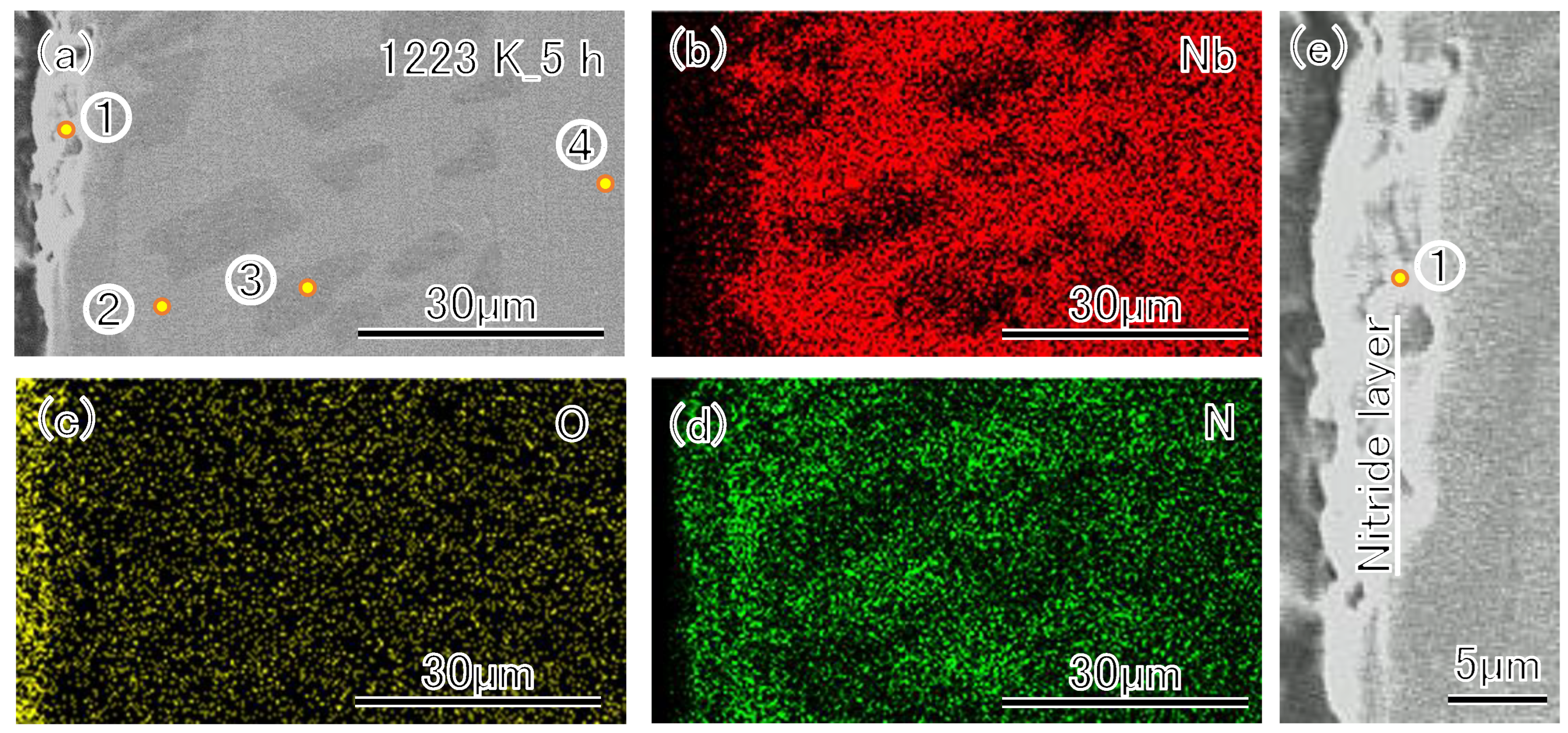
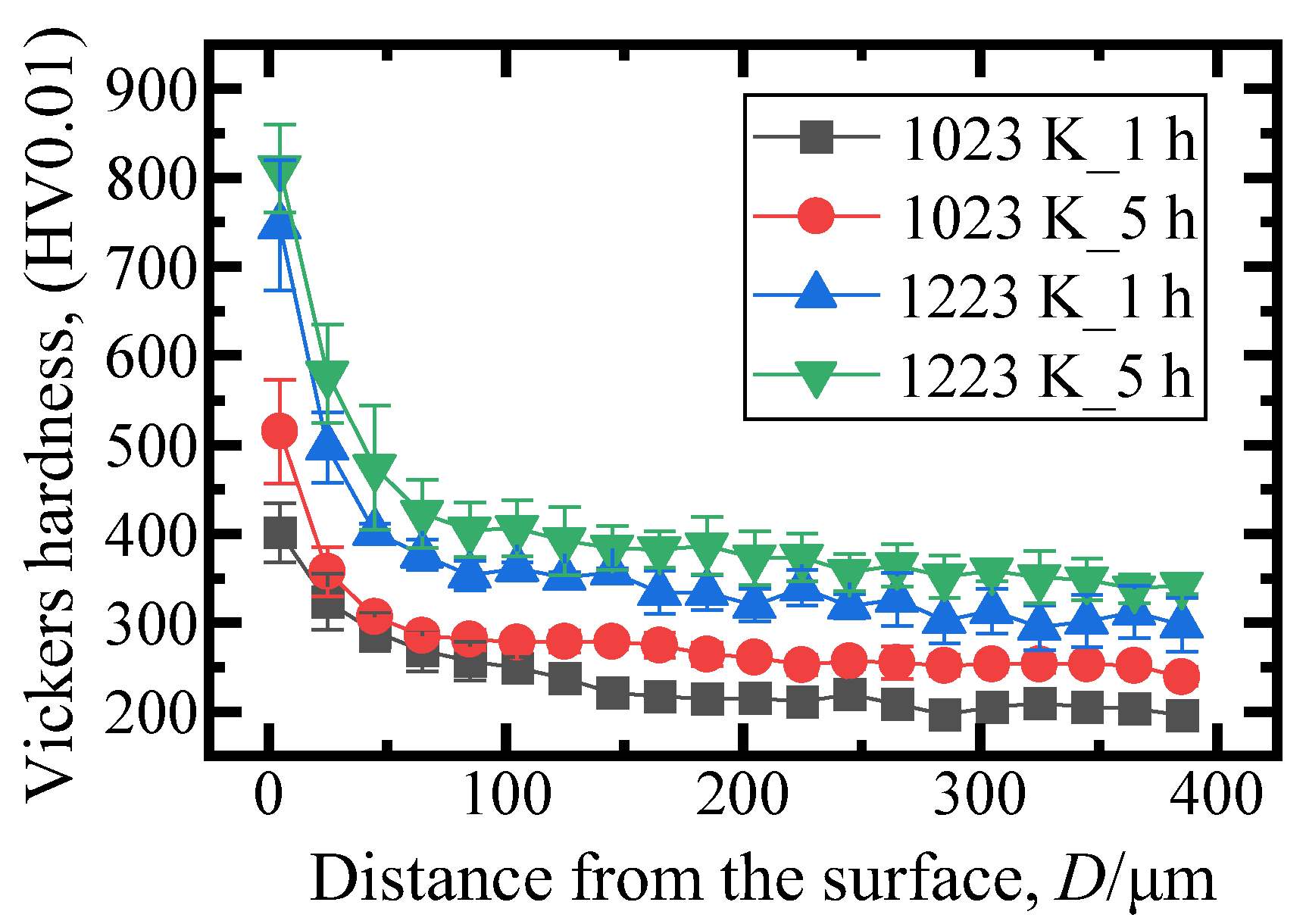

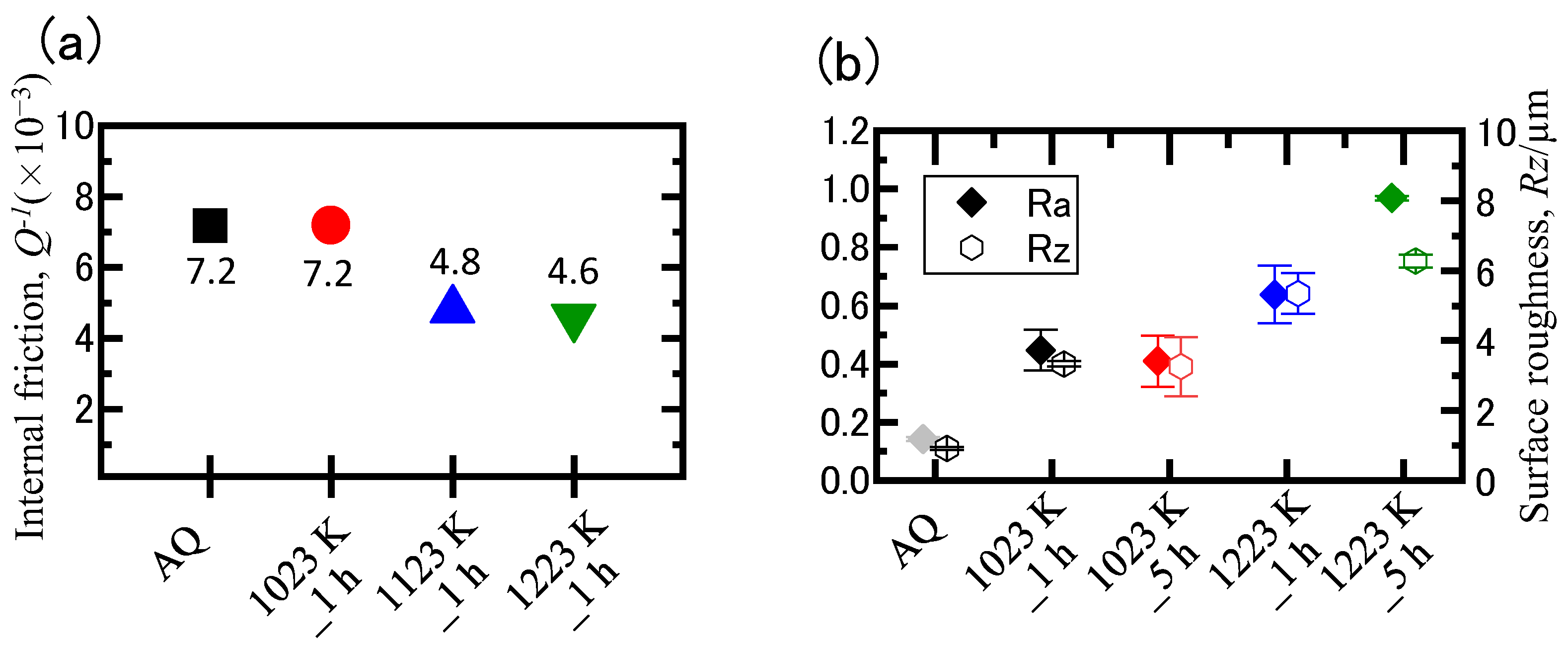
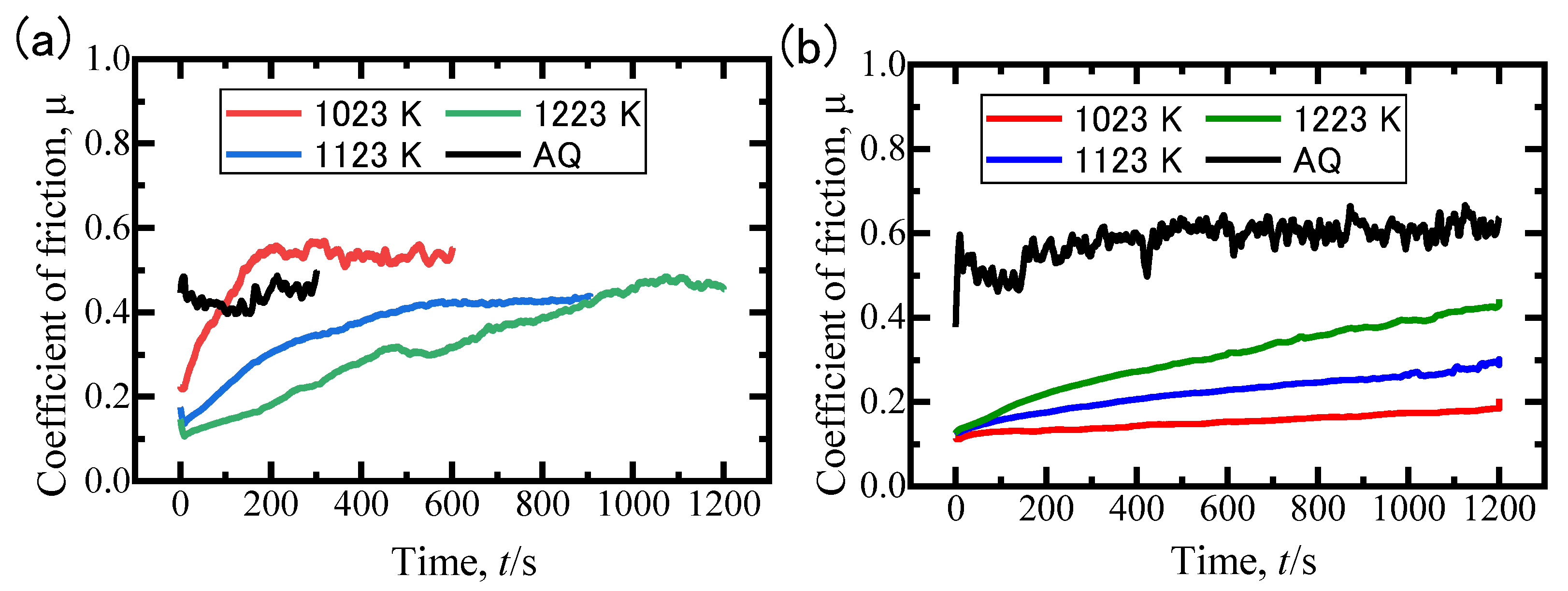
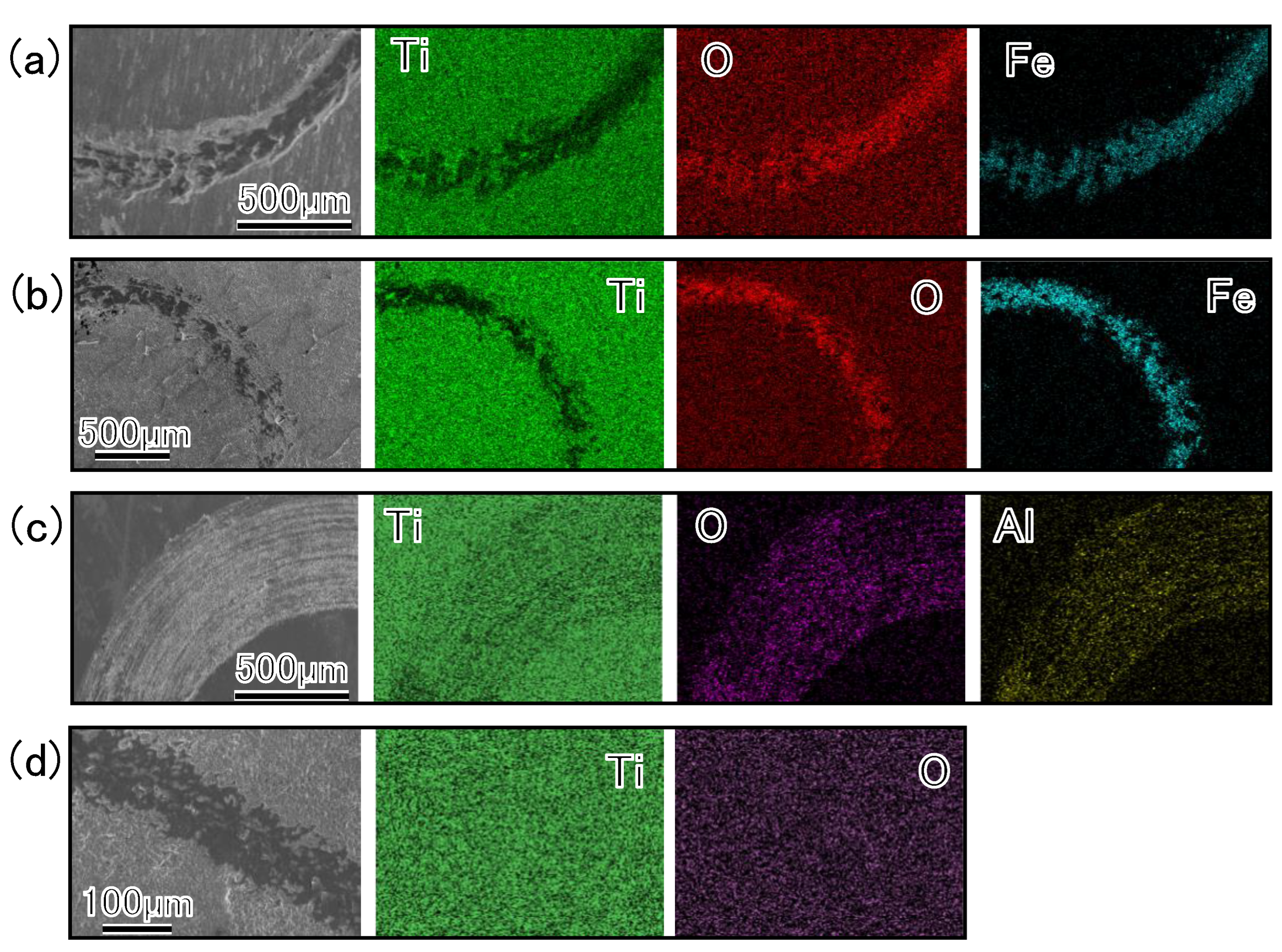
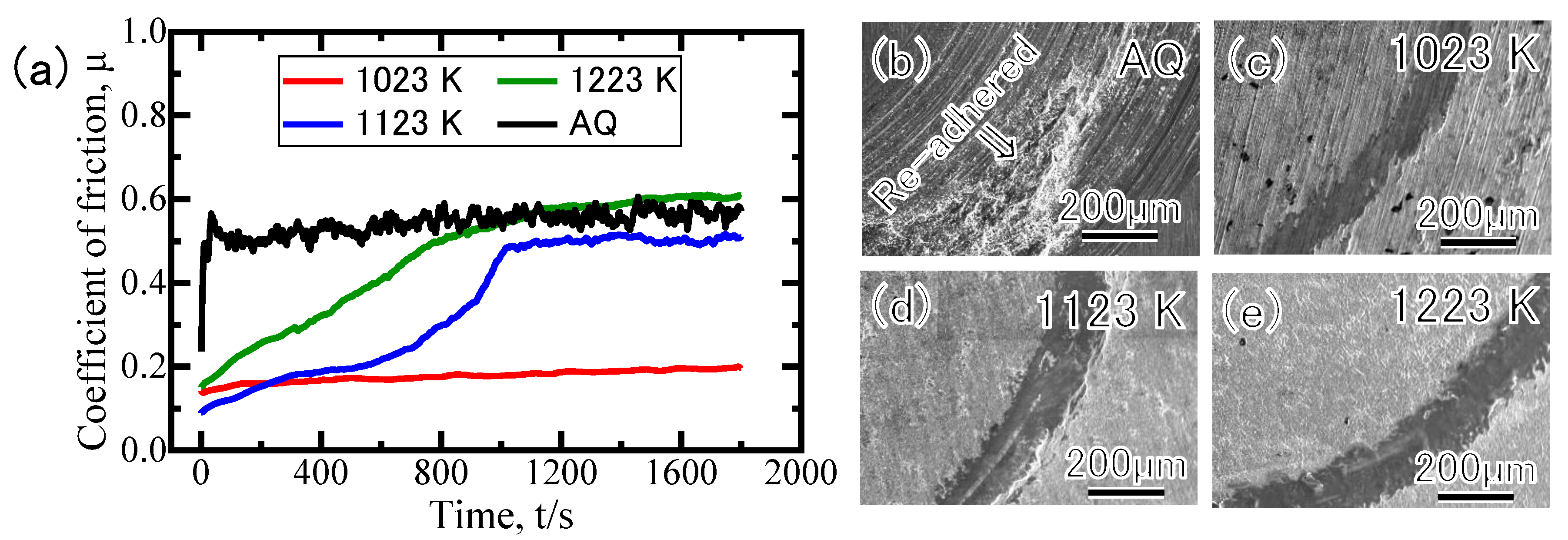
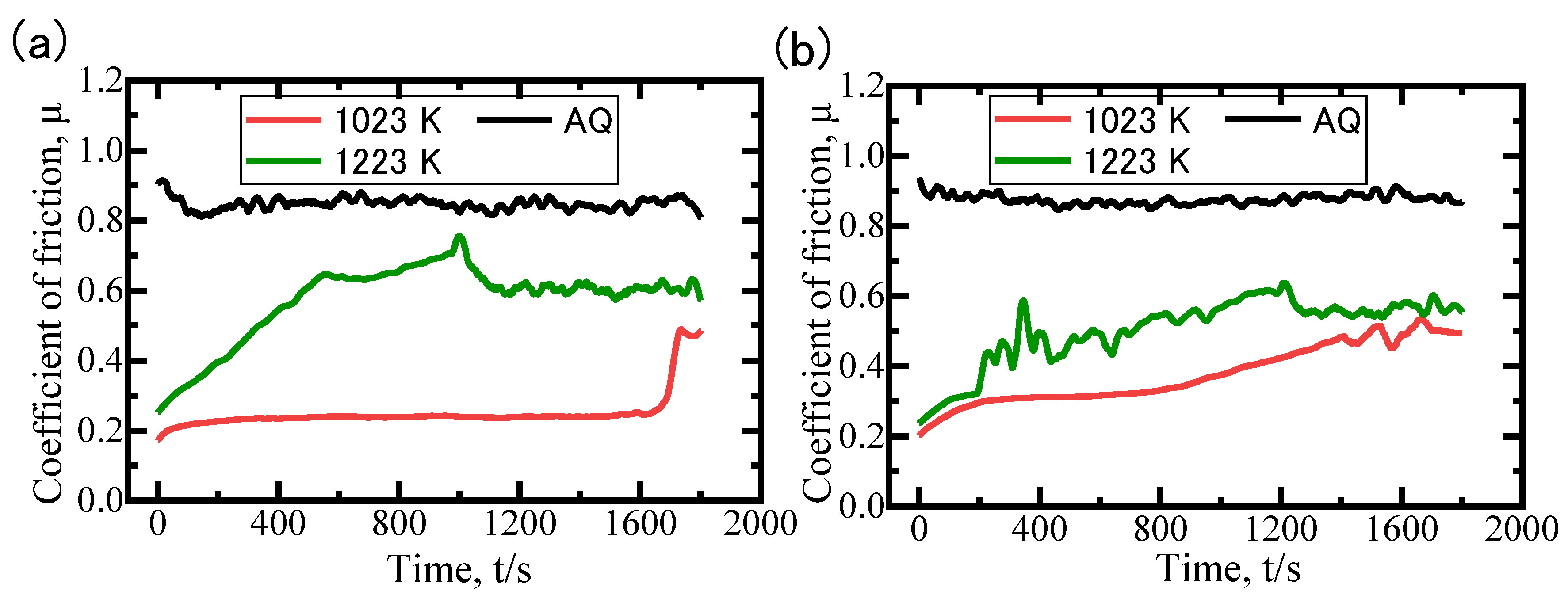
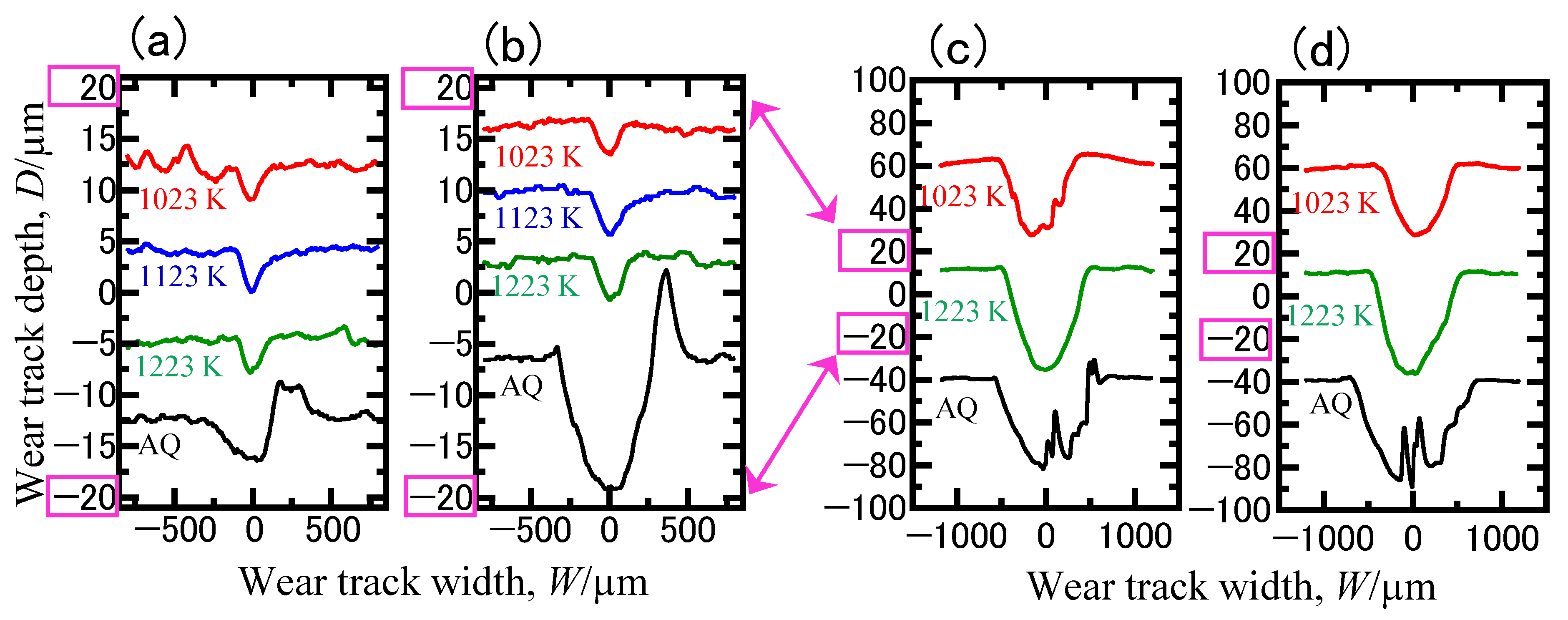
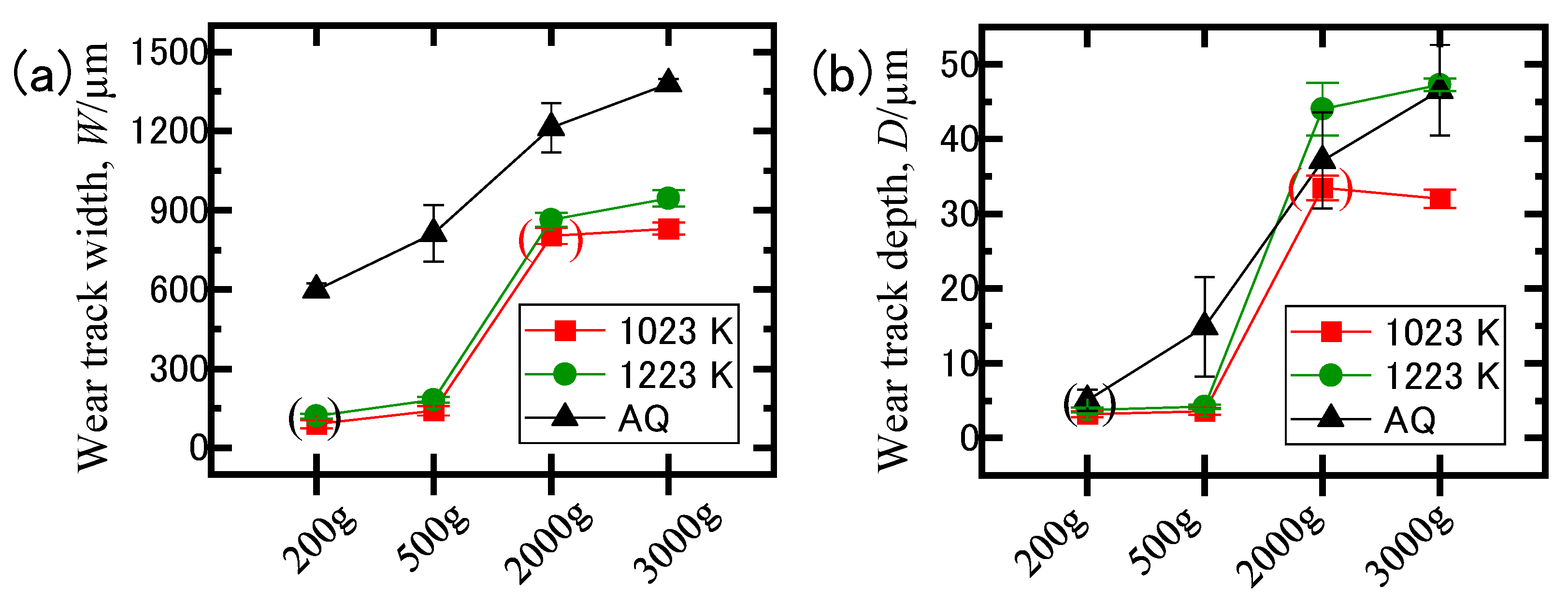
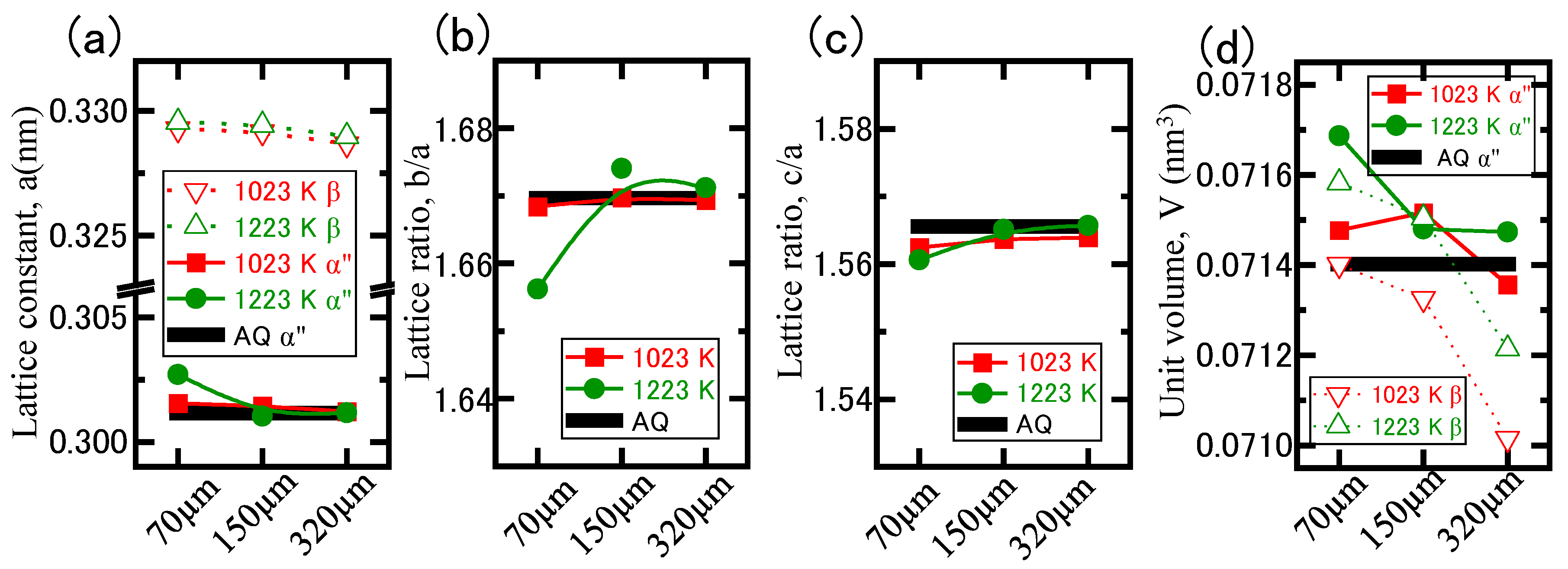
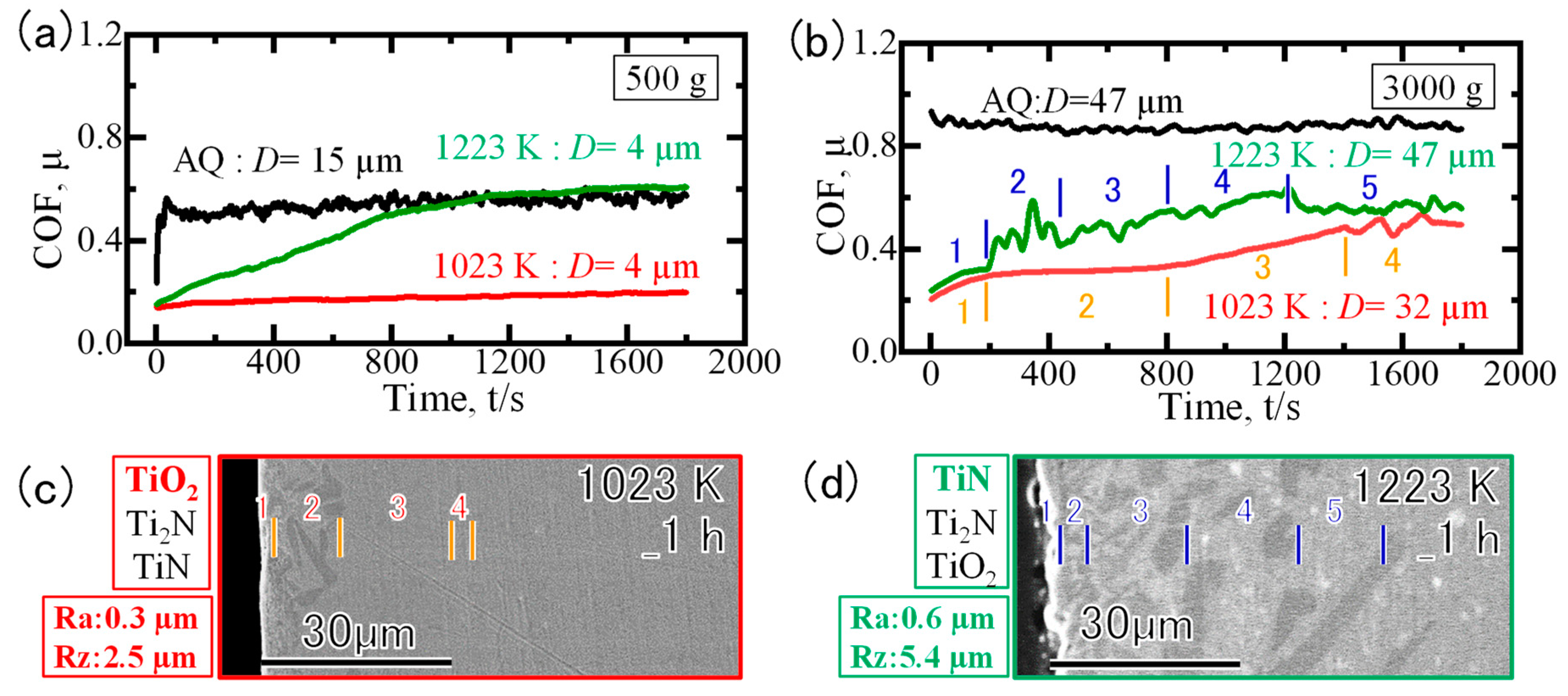
| AQ | Gas Nitriding and Quenching Process (GNQP) | |||||
|---|---|---|---|---|---|---|
| 1023 K_1 h | 1023 K_5 h | 1123 K_1 h | 1223 K_1 h | 1223 K_5 h | ||
| Cross section hardness | ✓ | ✓ | ✓ | ✓ | ||
| Cross section SEM | ✓ | ✓ | ✓ | ✓ | ||
| X-ray diffraction | ✓ | ✓ | ✓ | |||
| Internal friction | ✓ | ✓ | ✓ | ✓ | ||
| Suraface roughness | ✓ | ✓ | ✓ | ✓ | ✓ | |
| Friction wear test | ✓ | ✓ | ✓ | ✓ | ||
| mass% | at.% | |||||||
|---|---|---|---|---|---|---|---|---|
| Ti | Nb | N | O | Ti | Nb | N | O | |
| ① | 84.3 | 6.8 | 8.1 | 0.9 | 71.5 | 3.0 | 23.4 | 2.2 |
| ② | 71.4 | 27.9 | ― | 0.7 | 81.3 | 16.4 | ― | 2.3 |
| ③ | 83.3 | 14.2 | 2.5 | ― | 84.0 | 7.4 | 8.6 | ― |
| ④ | 80.0 | 20.0 | ― | ― | 88.6 | 11.4 | ― | ― |
Disclaimer/Publisher’s Note: The statements, opinions and data contained in all publications are solely those of the individual author(s) and contributor(s) and not of MDPI and/or the editor(s). MDPI and/or the editor(s) disclaim responsibility for any injury to people or property resulting from any ideas, methods, instructions or products referred to in the content. |
© 2024 by the authors. Licensee MDPI, Basel, Switzerland. This article is an open access article distributed under the terms and conditions of the Creative Commons Attribution (CC BY) license (https://creativecommons.org/licenses/by/4.0/).
Share and Cite
Mantani, Y.; Tsuji, M.; Akada, E.; Homma, T. Material Properties and Friction and Wear Behavior of Ti–18 mass% Nb Alloy after Gas Nitriding and Quenching Process. Metals 2024, 14, 944. https://doi.org/10.3390/met14080944
Mantani Y, Tsuji M, Akada E, Homma T. Material Properties and Friction and Wear Behavior of Ti–18 mass% Nb Alloy after Gas Nitriding and Quenching Process. Metals. 2024; 14(8):944. https://doi.org/10.3390/met14080944
Chicago/Turabian StyleMantani, Yoshikazu, Miku Tsuji, Eri Akada, and Tomoyuki Homma. 2024. "Material Properties and Friction and Wear Behavior of Ti–18 mass% Nb Alloy after Gas Nitriding and Quenching Process" Metals 14, no. 8: 944. https://doi.org/10.3390/met14080944





